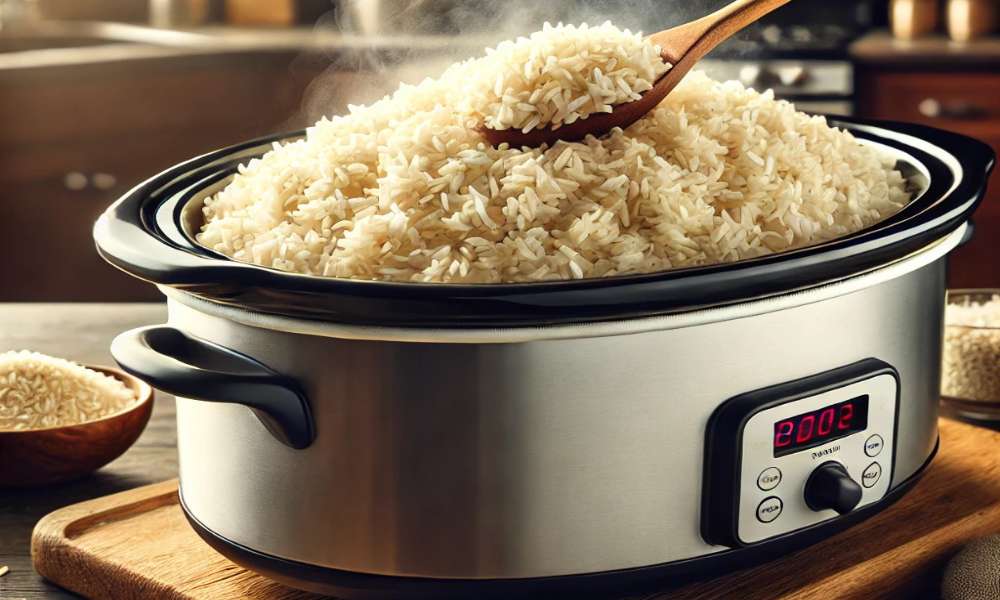Understanding how long to cook rice in a crock pot is essential for achieving perfectly tender grains with minimal effort. A slow cooker provides a hands-off approach, allowing rice to gradually absorb moisture and cook evenly, eliminating the need for constant supervision. Whether you’re making white rice, brown rice, or wild rice, knowing the right cooking time ensures a fluffy and flavorful result. Factors such as crock pot size, temperature setting, and rice-to-water ratio all play a role in determining the ideal cooking duration. In this guide, we’ll explore everything you need to know about cooking rice in a slow cooker, from choosing the right rice to troubleshooting common issues.
Understanding Rice Cooking Time in a Crock Pot
The size of the crock pot significantly influences the cooking time of grain. Smaller slow cookers (2-4 quarts) tend to heat up faster and may require a shorter cooking duration, whereas larger models (6-8 quarts) distribute heat more evenly but might take longer to bring the liquid to a boil. Typically, white rice cooks within 2 to 3 hours on a low setting and 1 to 2 hours on high. Brown rice, being more fibrous, needs 3 to 4 hours on low and around 2 hours on high. Wild rice, known for its hardy texture, can take up to 5 hours on low. Several elements influence the precise cooking time, including grain variety, liquid ratio, temperature setting, and altitude.
Best Types of Rice for Slow Cooking
Not all rice varieties perform equally well in a crock pot. Understanding which type suits your needs can make a significant difference.
- White Rice: Long-grain, jasmine, and basmati are ideal for light, fluffy results.
- Brown Rice: Requires more liquid and time but provides a nutty flavor and added nutrition.
- Wild Rice & Specialty Rice: Quinoa, arborio, and black rice take longer but offer unique textures and flavors.
Quick Tips
For optimal results, opt for grain varieties that maintain structure after prolonged cooking. Avoid parboiled or instant grain, as they tend to become overly soft in a slow cooker.
Water-to-Rice Ratio
Getting the ratio right is critical for perfectly cooked grain. Standard guidelines include:
- White Rice: 1 cup rice to 2 cups water
- Brown Rice: 1 cup rice to 2.5 cups water
- Wild Rice: 1 cup rice to 3 cups water
Adjust these ratios slightly depending on your preference for softer or firmer grain. Cooking with broth instead of water enhances the flavor profile.
Step-by-Step Guide
Ingredients Needed:
- 1 cup of chosen rice
- 2-3 cups of water or broth (depending on rice type)
- 1 teaspoon salt (optional)
- 1 tablespoon butter or oil (optional)
Cooking Instructions:
- Rinse: This removes excess starch, preventing clumping.
- Combine Ingredients: Add rice, liquid, salt, and butter into the crock pot.
- Set Temperature: Cook on low for best results or high for quicker preparation.
- Monitor Cooking Time: Check after the minimum suggested time to ensure desired doneness.
- Fluff and Serve: Once done, fluff the rice with a fork to separate grains.
Troubleshooting Common Issues
The size of your crock pot plays a role in potential cooking problems. In a smaller crock utensil, rice may cook unevenly due to higher heat concentration, whereas in a larger model, grain might dry out if not enough liquid is used. If you are experiencing mushy grain, reduce the water ratio slightly and avoid lifting the lid frequently. For dry grain, add a small amount of warm water and cook for an additional 15 minutes while ensuring the lid remains sealed. Uneven cooking can often be fixed by stirring the grain once halfway through cooking and using a crock utensil with even heat distribution. Read, Cook Brown Rice In A Rice Cooker
Tips for Making the Best Crock Pot Rice
The crock pot’s capacity affects how rice turns out. A larger pot may require more frequent stirring to ensure even cooking, while a smaller model retains moisture more efficiently. Using broth instead of water enhances the taste, and adding aromatics such as garlic, bay leaves, or onion can further elevate the flavor. Experimenting with seasonings like turmeric, cumin, or smoked paprika can help create a richer taste. To avoid overcooking, turn off the slow cooker once the grain is fully tender and let it sit for a few minutes before serving.
Storing
The crock utensil’s size can also impact how much rice you prepare at once, which directly affects storage and reheating needs. If you cook a large batch in an 8-quart slow cooker, consider dividing it into smaller portions for easier storage. Store cooked grain in an airtight container in the fridge for up to 5 days, or freeze it for up to 3 months in portioned containers. When reheating, adding a splash of water and covering the grain while microwaving helps retain moisture. Reheating on the stovetop with a small amount of broth can also prevent dryness and restore the rice’s texture. Leftover grain can be repurposed into stir-fry dishes, added to soups, or mixed with eggs and seasonings to make grain patties.
Conclusion
Cooking grain in a crock utensil is a simple yet effective method that ensures perfect results with minimal effort. By understanding the correct cooking times and water ratios for different grain varieties, anyone can achieve consistently delicious, fluffy grains. Experimenting with seasonings and broth can elevate a basic dish into a flavorful centerpiece. Whether meal prepping or simply seeking a fuss-free way to cook grain, the crock utensil remains a valuable kitchen tool for efficiency and taste.
